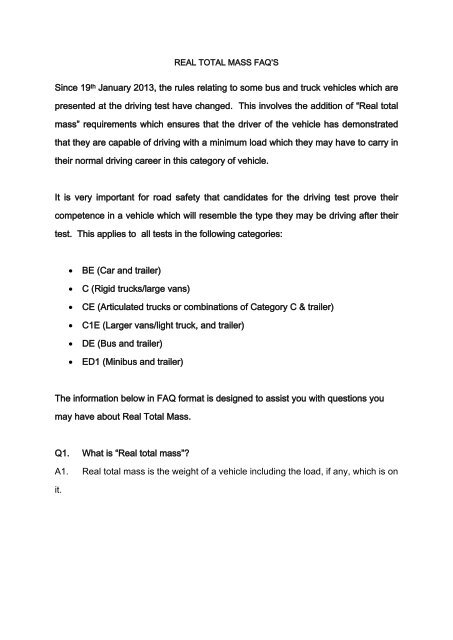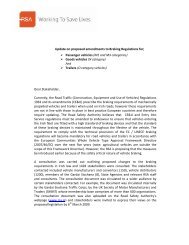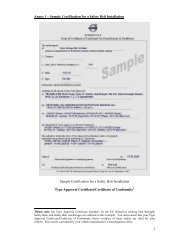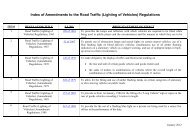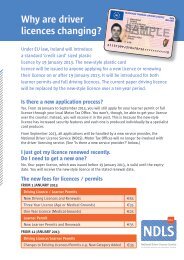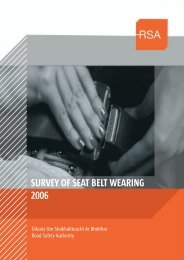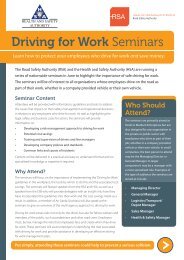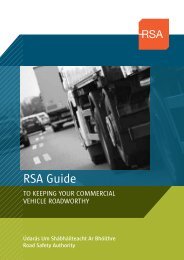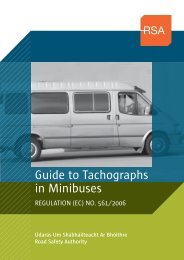Real total mass FAQ's - Road Safety Authority
Real total mass FAQ's - Road Safety Authority
Real total mass FAQ's - Road Safety Authority
Create successful ePaper yourself
Turn your PDF publications into a flip-book with our unique Google optimized e-Paper software.
REAL TOTAL MASS FAQ’SSince 19 th January 2013, the rules relating to some bus and truck vehicles which arepresented at the driving test have changed. This involves the addition of “<strong>Real</strong> <strong>total</strong><strong>mass</strong>” requirements which ensures that the driver of the vehicle has demonstratedthat they are capable of driving with a minimum load which they may have to carry intheir normal driving career in this category of vehicle.It is very important for road safety that candidates for the driving test prove theircompetence in a vehicle which will resemble the type they may be driving after theirtest. This applies to all tests in the following categories:• BE (Car and trailer)• C (Rigid trucks/large vans)• CE (Articulated trucks or combinations of Category C & trailer)• C1E (Larger vans/light truck, and trailer)• DE (Bus and trailer)• ED1 (Minibus and trailer)The information below in FAQ format is designed to assist you with questions youmay have about <strong>Real</strong> Total Mass.Q1. What is “<strong>Real</strong> <strong>total</strong> <strong>mass</strong>”?A1. <strong>Real</strong> <strong>total</strong> <strong>mass</strong> is the weight of a vehicle including the load, if any, which is onit.
Q.2 Why might I need to have a load on the vehicle during my driving test?A. 2 It is important to bear in mind that the point of having a vehicle with aminimum real <strong>total</strong> <strong>mass</strong> for driving test purposes is to make sure that driversdemonstrate their competence in a vehicle which will be similar to the kind of vehiclethe full licence will allow them to drive after their test. For Categories BE, C1E DEand D1E, in all cases, irrespective of the weight of the trailer unladen, there is arequirement to load the trailer. In the other relevant categories, (categories C, CE,and D) the vehicle must only be laden if the unladen weight of the vehicle does notalready meet the requirement.Q3. What is the minimum real <strong>total</strong> <strong>mass</strong> that is required for the driving test sincethe 19 th January 2013?A3. There are different real <strong>total</strong> <strong>mass</strong> requirements depending on the category ofvehicle. These requirements are notified to every test applicant in their testappointment notification and are detailed in the following table:CategoryC (Truck)BE (Car andtrailer)<strong>Real</strong> Total Mass RequirementThe vehicle must be presented with a real <strong>total</strong> <strong>mass</strong> (theactual weight of the vehicle including any load if necessary) ofat least 10,000kg, having due regard for safety, stability,manufacturer’s guidelines and legal limits.The trailer must be presented with a real <strong>total</strong> <strong>mass</strong> (theactual weight of the trailer including the necessary load) of atleast 800kg, having due regard for safety, stability,manufacturer’s guidelines and legal limits of thecombination.For these categories, in every case, irrespective of the weightof the trailer unladen, the trailer must be presented with aload of 30 four inch (100 x 220 x 450mm) solid concretebuilding blocks (see Figure 2 below), to ensure that it meetsminimum real <strong>total</strong> <strong>mass</strong> requirements for the test (real <strong>total</strong><strong>mass</strong> is the actual weight of the trailer including the
necessary load), having due regard for safety, stability,manufacturer’s guidelines and legal limits of thecombination.CE (Artic ortruck andtrailercombination)C1E(Light truckand trailer)DE (Bus andtrailer)D1E (Minibusand trailer)The articulated vehicle or the combination must bepresented with a real <strong>total</strong> <strong>mass</strong> (the actual weight of thecombination including any load if necessary) of at least15,000kg, having due regard for safety, stability,manufacturer’s guidelines and legal limits of thecombination.The trailer must be presented with a real <strong>total</strong> <strong>mass</strong> (theactual weight of the trailer including any load if necessary) ofat least 800kg, having due regard for safety, stability,manufacturer’s guidelines and legal limits of thecombination.The trailer must be presented with a real <strong>total</strong> <strong>mass</strong> (theactual weight of the trailer including any load if necessary) ofat least 800kg, having due regard for safety, stability,manufacturer’s guidelines and legal limits of thecombination.The trailer must be presented with a real <strong>total</strong> <strong>mass</strong> (theactual weight of the trailer including any load if necessary) ofat least 800kg, having due regard for safety, stability,manufacturer’s guidelines and legal limits of thecombination.Q3. How will I ensure my vehicle meets the requirements on the day of the test?A3. This will depend on the vehicle category you are sitting your driving test in.The following table outlines the requirements which you need to meet for real <strong>total</strong><strong>mass</strong> for each vehicle category:
Vehicle Category• BE(Car/Jeep andTrailer)How to meet the <strong>Real</strong> Total Mass requirementIn all cases for categories BE, DE, C1E and D1E, loading ofthe trailer will be met by placing thirty x 4” (inch) solid concreteblocks in the trailer (see Figure 2).• DE(Bus and Trailer)The blocks should be evenly distributed across the trailer andpositioned in such a way as to keep the nose weight within therecommended limits.• C1E(Large van/lighttruck and Trailer)The nose weight is the maximum load your trailer can put onyour vehicle’s tow ball (set out by the vehicle manufacturer).The suggested figure for a safe nose weight when towing is• D1Earound 7 per cent of the laden weight of the trailer.(Minibus andTrailer)The trailer should be loaded in a way as to ensure individualwheels /axles are not overloaded, having due regard for safety,stability, manufacturer’s guidelines and legal limits of thecombination.Also remember that in order to comply with the law, the brakingand lighting systems must be functioning correctly and thegeneral structure must be sound.C (Trucks)You firstly must establish the unladen weight of the truck – theunladen weight is stated on the vehicle’s CRW (Certificate ofCommercial Vehicle <strong>Road</strong>worthiness) under U.L.W. (UnladenWeight).
If the unladen weight of the vehicle meets or exceeds the real<strong>total</strong> <strong>mass</strong> requirement stated in Question 3 above (i.e.10,000kg), then you will not need to add any additional load tothe vehicle for the driving test. You must bring the Certificateof Commercial <strong>Road</strong>worthiness with you to the Driving Test topresent to the Driver Tester so that they can check the unladenweight.If the unladen weight does not meet the real <strong>total</strong> <strong>mass</strong>requirement stated in Question 3 above (i.e. 10,000kg), thenyou must first establish the difference between the unladenweight of the vehicle and the real <strong>total</strong> <strong>mass</strong> requirement. Forexample, if the unladen weight of the vehicle is 8,000kg, andthe requirement is 10,000kg, then you need to place 2,000kgminimum on the vehicle to meet the requirement.The RSA requires that IBC’s (Intermediate Bulk Containers)filled with water are placed securely on the back of the vehicle(see Figure 1). IBC’s have a stated capacity – e.g. a 1,000 litreIBC when filled with water will weigh 1,000kg (1 tonne).In the example above, two 1,000 litre IBC’s filled with waterloaded securely on the back of the vehicle would meet theminimum requirement for the driving test.You must bring the current Certificate of Commercial<strong>Road</strong>worthiness (pass statement is not acceptable) with you tothe Driving Test to present to the Driver Tester so that they cancheck the unladen weight. Please check the expiry date of the
CRW to ensure that, should it expire before the testappointment, you have time to have the vehicle tested andhave a new CRW issued to you to present at the test.CE(Articulated trucks orcombinations of categoryC truck and Trailer)In order to establish the unladen weight of the tractor unit andthe trailer together, you must get both weighed together at aweighbridge. You will receive a certificate or receipt from theweighbridge, which you must bring to the driving test with youto show to the Driver Tester and which must contain:• The registration number of the tractor unit• The trailer mark of the trailer being presented for thedriving test• The unladen weight of the tractor unit and trailertogether• The date the vehicle was weighedIf the unladen weight of the vehicle meets or exceeds the real<strong>total</strong> <strong>mass</strong> requirement stated in Question 3 above (i.e.15,000kg), then you will not need to add any additional load tothe vehicle for the driving test. You must bring the weighbridgecertificate with you to the Driving Test to present to the DriverTester so that they can check the unladen weight.If the unladen weight does not meet the real <strong>total</strong> <strong>mass</strong>requirement stated in Question 3 above (i.e. 15,000kg), thenyou must first establish the difference between the unladenweight of the vehicle and the real <strong>total</strong> <strong>mass</strong> requirement. For
example, if the unladen weight of the vehicle is 12,000kg, andthe requirement is 15,000kg, then you need to place 3,000kgminimum on the vehicle to meet the requirement.The RSA requires that IBC’s (Intermediate Bulk Containers)filled with water are placed securely on the back of the vehicle(see Figure 1). IBC’s have a stated capacity - a 1,000 litre IBCwhen filled with water will weigh 1,000kg (1 tonne).In the example above, three 1,000 litre IBC’s filled with waterloaded securely on the back of the vehicle would meet theminimum requirement for the driving test.IMPORTANT NOTE FOR ALL CATEGORIESPlease note that the weight of the vehicle/vehicle and trailer, when loaded must notexceed any of the plated axle weights or plated maximum authorised <strong>mass</strong> of thatparticular vehicle/trailer. You must have due regard for safety, stability, and manufacturer’sguidelines and legal limits of vehicles or combinations. You must refer to thespecific Vehicle Manufacturers Guidelines to ensure recommended weights are notexceeded.Q4. Why do I have to use IBC’s if I have to load category C & CE?A4. In order for the Driver Tester to determine that the vehicle meets therequirements of real <strong>total</strong> <strong>mass</strong>, a universal manner of displaying real <strong>total</strong> <strong>mass</strong> isrequired. The use of IBC’s is seen to be the most identifiable method. The use of,say, a concrete slab, would not be easily identifiable in terms of <strong>mass</strong>. IBC’s arereadily available and are relatively inexpensive, or could be borrowed, and do notrequire the test applicant to get certification from a weighbridge, for example. You
may be required to open the back of the vehicle in order for the tester to check thatthe load is in place.Figure 1 – IBC (Intermediate Bulk Container)Q5. Why 4” concrete blocks for categories BE, DE, C1E, and D1E?A5. In order for the Driver Tester to determine that the vehicle meets the real <strong>total</strong><strong>mass</strong> requirements, a universal manner of displaying real <strong>total</strong> <strong>mass</strong> is required.The use of concrete blocks for categories BE, DE, C1E & D1E was found to be themost satisfactory for ease of access and loading on the vehicle for the customer, andas being easily identifiable for the Driver Tester. If it is accepted that a trailer willweigh a minimum of 250kg on its own, the 30 blocks (each weighing approximately19-20kg) will weigh an additional 570kg, which together will exceed the minimumreal <strong>total</strong> <strong>mass</strong> requirement of 800kg at 820kg. As outlined above, the blocks arerequired in every case, irrespective of whether the trailer already weighs 800kg whenempty.You may be required to open the door of the trailer in order for the tester to checkthat the load is in place.
Figure 2 – A four inch solid concrete block (4” x 9” x 18”)Q6. My car/jeep trailer/horse box already weighs 800 kg when empty – do I still haveto load it for the category BE test?A5 Yes, as many such trailers are not required to display the unladen weight, thedriver tester must be in a position to immediately be satisfied as to the real <strong>total</strong><strong>mass</strong> presented. Therefore, if every such trailer is loaded with the 30 4” concreteblocks as outlined above, the real <strong>total</strong> <strong>mass</strong> requirement is met. This loading withblocks is required in every case, irrespective of whether the trailer already weighs800kg. Test applicants must ensure that the trailer is capable of carrying the loadand that neither the trailer, the vehicle nor the vehicle hitch are overloaded.


